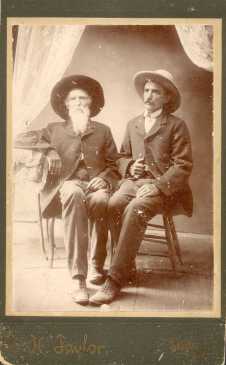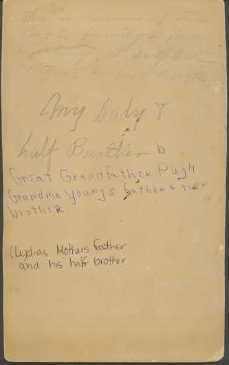 |
 |
| Front | Back |
In this case study, three different people wrote captions on the back of a photograph. The earliest identifies the image as “My dady (sic) + half brother.” Other individuals named the men as “Great Grandfather Pugh, Grandma Youngs father + her brother” and “Lydia’s Mother’s father and his half brother.” Confused by the information on the back, Jennifer Walls submitted the image for further clarification.
When you see a caption with a photograph, the temptation is to accept it as truth. However, identifying information can be written by anyone at any time in the history of the photograph. The person supplying the data may not have known the individuals in the image and unknowingly passed on incorrect names and dates. If the person who wrote the information actually knew the people in the photograph, then the data becomes more reliable. In order to verify the caption, it is still necessary to double-check the other identifying clues in the image to make sure that all the data agree. For instance, the photographer’s imprint, costume clues and even type of photography should support the dates given or implied in the caption.
A first step is to try to determine who supplied the information. One way is to try to establish who owned the photograph based on family oral history. Relatives may know the story behind the picture or even recognize the handwriting.
Handwriting can also help you place the caption within a time frame. Tamara Plakins Thornton’s Handwriting in America: A Cultural History (Yale University Press, $16.95) outlines the history and types of handwriting styles taught in earlier generations. If the handwriting on the photograph is from the same time period as the photograph you might be able to assign names and dates to family members in the photograph. Another way to use handwriting is to compare what appears on the image with handwriting samples in your family papers.
In this case, the current owner knows that her great grandmother, Sarah (Pugh) Young, originally owned this picture. It is therefore possible that she knew both of the men in the image and wrote the first caption. If so, then the older man in the photograph according to the caption was Sarah’s father, Henry Martin Pugh, and one of her brothers. But which one? It could not be established who wrote the other captions.
Genealogical research can uncover further information once there is a tentative identification. Jennifer Walls contacted a relative who is compiling a history of the family for additional details on the individuals in the photograph. They found a biography of Henry Martin Pugh on Ancestry.com in The Biographical and Historical Memoirs of Western Arkansas (1891). It contained an outline of Mr. Pugh life including his military service on both sides of the Civil War and the places he lived. The fact that he lived in Yell County, Ark., until 1902 and then moved to Johnston County, Okla., supports the identification. Mr. Pugh had one daughter, Sarah and two sons, William Thomas and James Madison. Since research shows that only James Madison Pugh lived in Oklahoma, he may be the younger man in the photograph. Ordinarily it would be helpful to compare other family photographs of the two men to determine who is depicted with the father. However, in this family, the mothers of the two sons were sisters and shared facial similarities.
The photographer’s imprint, “A.H. Taylor, Sulpher I.T.,” helps date the image. The I.T. in the imprint stands for Indian Territory, the name of Oklahoma prior to statehood in 1907. The curator of photographs at the Oklahoma Historical Society verified with city directories and newspapers that A.H. Taylor worked in the area around 1905. This establishes a firm date for the photograph.
The costume details also agree with the date. Both men wear single-breasted loose jackets with workpants and boots. It is interesting that both men have only the top button of their jackets buttoned. Their hats are modified sombreros. The older man’s hat is a little more relaxed due to wear while his son’s hat looks brand new. It would be interesting to know when the son moved to Oklahoma; it may have been the occasion for the portrait. The photographer’s studio is a sparse arrangement of simple stools and a single table. The only decoration is a draped curtain and a tablecloth. The setup is a temporary studio that could easily be moved to another location if necessary.
In this image, the genealogical research and photographer’s imprint dated the picture and verified the caption. The costume analysis only confirmed the date. While the older man is almost certainly Henry Martin Pugh the identity of the son remains uncertain. However, it is reasonable to assume it is James since he is the only brother to live in Oklahoma.
Find out how to submit your own picture for possible analysis by Maureen Taylor. E-mail her at mtaylor@taylorandstrong.com.




